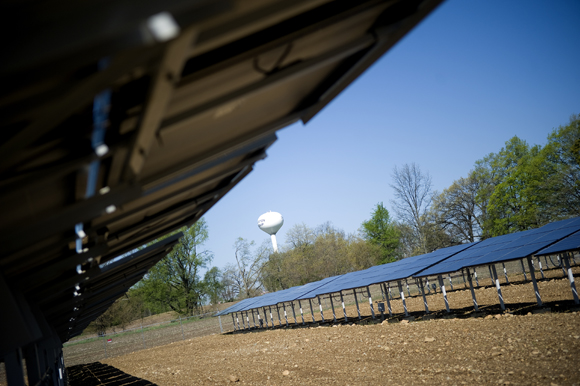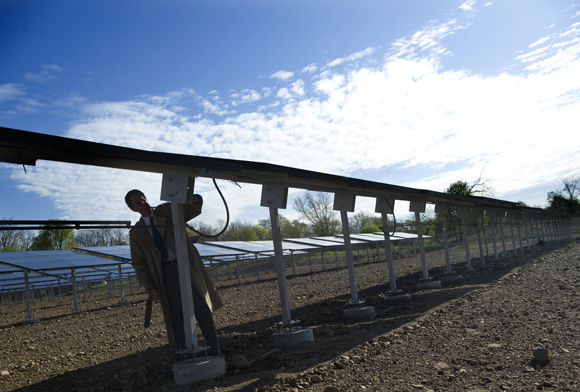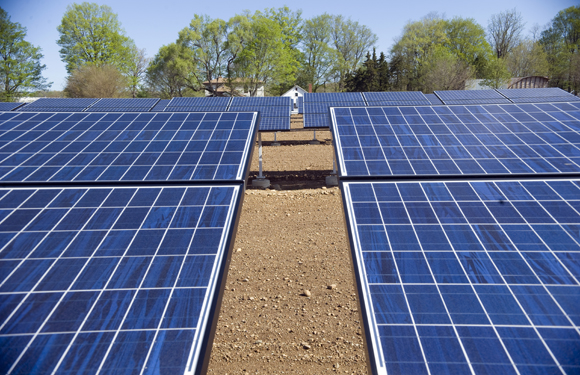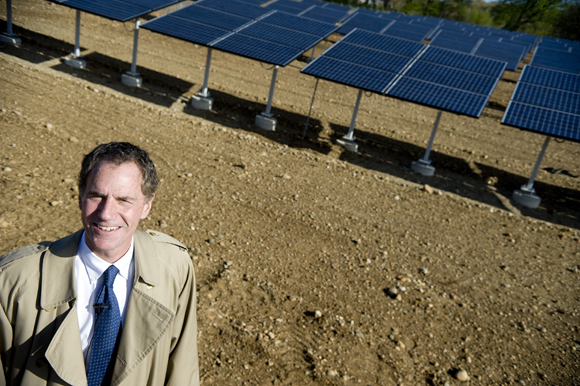A harvest of sunshine
A solar array surrounded by corn and soy bean fields is an experiment on a grand scale for Connor Field and his father, Sam. Writer Stacie Carlson talks to them about what their learning about creating solar power from their massive do-it-yourself project.
Anyone who thinks of Michigan as a land of ice and snow may be surprised to learn even in sun-starved winter there’s enough sunshine to produce solar energy.
To capture that energy, a father and son team has built a 1.5 acre solar energy farm, called a solar array, between Battle Creek and Kalamazoo.
As you walk the property, it’s an other-worldly sight and it was quite a gamble economically — think around $1 million, out of private pockets.
Sam and Connor Field, father and son, along with their close friend, Richard Schmitt, created the company, Kalamazoo Solar, LLC, in 2009. Together they went on to build the state of Michigan’s largest and most economically built solar array, using their own innovative designs, production, and bare hands — with no guarantee it will ever turn a profit.
“It was a love labor,” Sam Field says. “The truth is that we really believe in this technology. There’s literally a technological revolution in solar energy happening right now and it’s exciting to be a part of it.”
The partners chose Charleston Township for the project because they all live in Southwest Michigan.
“I have lived most of my life in Kalamazoo,” Connor Field says. “We all recognize that the Michigan economy is struggling and we want to do our part to create local jobs and economic activity.”
Using Connor Field’s innovation and creativity the three got to work building the business. They used 45,000 pounds of steel and 15,000 pounds of rebar to build 126 racks on which the 756 solar panels are mounted. Each panel is 37.5 feet by 65 feet in size. There are 100 yards of concrete in the foundations. To connect all the components took more than 10 miles of pencil sized wire.
On Schmitt’s farmland, where soy beans and corn grew, an entirely different kind of crop has grown up. It’s one the Fields think could sustain the country.
“Ten percent of America’s agricultural land is devoted to corn for ethanol,” Sam Field says. “If just that portion was devoted to solar, we’d have enough energy to power all of America.”
From a power perspective, the possibilities are electrifying.
Solar energy supporters say Michigan has an average of 4.2 hours of peak sunlight per day each year. The “Sunshine State,” Florida, has about five hours. While other parts of the country might have more sunlight, solar power is created more efficiently in Michigan because the panels don’t overheat, supporters say. Solar panels are less efficient the hotter they get and actually produce more power when it gets cooler.
“Our array doesn’t negatively impact birds or other area wildlife like other forms of alternative energy may,” Sam Field says. “Don’t get me wrong: We love wind. But we wanted to try for something different.”
So they set about building a solar array.
“My son designed the entire system,” Sam Field says. “He set up the factory, designed the tooling, built the racking, and didn’t charge a thing. We all worked for free.”
They built the project at the lowest possible cost, using off-the-shelf components.
“Believe me,” says Connor Field, “there’s not a ‘commercial scale photovoltaic array’ section at Home Depot.”
Months later, the partners have seen their labors producing electric power as expected.
“The array went live recently,” Sam Field says. “We connected to Consumer Energy’s grid in February and we are now pouring power directly into Consumer’s Energy. Daily, we produce enough energy to fuel 20 to 25 local homes or 800 to 1,000 kilowatt hours.”
On a good day, the array can produce 1,000 kilowatt hours or seven hours of power. Other solar arrays in Michigan produce on average about four hours of power a day.
What made the project possible was a Michigan law enacted in October 2008 that mandates 10 percent of all energy production by companies like DTE and Consumers Energy come from renewable means. It is known as a feed-in tariff and it means a company like Consumers Energy can now buy power at a fixed rate from companies like Kalamazoo Solar that create power through renewable sources.
The partners have a 12-year contract to feed their energy to Consumer’s Energy. They hope they can at least recoup their expenses.
“The return on the project is uncertain,” Connor Field says. “But it’s the pioneers in the industry who take the risks necessary to move technology forward. The real benefit isn’t the revenue it generates, it’s the value of learning how to adopt ever-improving technologies.”
In addition to technological advances, the Charleston Township solar array helped push Connor Field’s educational goals in a new direction. He had been pursuing a degree in economics, now he’s added engineering and is on track to graduate in 2012.
“This project caused me to realize the value of an engineering education,” Connor says. “I quickly realized that if I want to be serious about being in the solar photovoltaic industry, I would need to have some engineering background. This project was simply the final push in that direction.”
Connor Field goes on to say that the returns from the solar project aren’t necessarily financial in nature. “There’s not a price that can be placed on the fact that this project produces no pollution whatsoever. There are no CO2 or heavy metal emissions, unlike coal or natural gas production.”
As competition and innovation continue in the solar energy field, the Fields anticipate solar will continue to grow as a source of power.
The array is getting good responses from the community, too.
“Everyone we talk with loves the notion of renewable energy,” Sam Field says. “Most people see the advantages of using Michigan sunshine to power Michigan households. They love that we’re staying local. Plus, all of the materials and labor that could be kept in Michigan was kept here. We built and designed it all right here in Southwest Michigan.”
No one from the community has challenged the building of the solar array, although some have questioned its economic viability as a stand-alone industry. The concern is a real one, the Fields agree.
“That’s true,” says Connor Field. “In reality, few infant industries are able to stand up without support. It was just 100 years ago when the petroleum and automotive industries needed subsidies to be competitive.”
The solar array also faces the challenge of local property taxes. It is taxed differently than farmland is normally taxed. The township says the property is more valuable with solar panels sprouting from it. So the partners are calling for an abatement in their taxes to encourage alternative energy programs like theirs.
“Our tax bill for the year is $27,000,” Sam Field says, although the array does not make enough electricity to pay that much in taxes. “It’s a really tough issue. We’re hoping that our taxes can be abated to make solar energy competitive.”
Stacie Carlson is a freelance writer who lives and works in Kalamazoo.
Photos by Erik Holladay
Sam Field stands illuminated in the light that is behind the business he and his son, Connor, have created.
Sam Field handled the business aspects of creating the solar array, while his son, Connor, developed the plans and did the hard larbor behind installing the panels.
Sam Field explains the expense of power inverters.




















